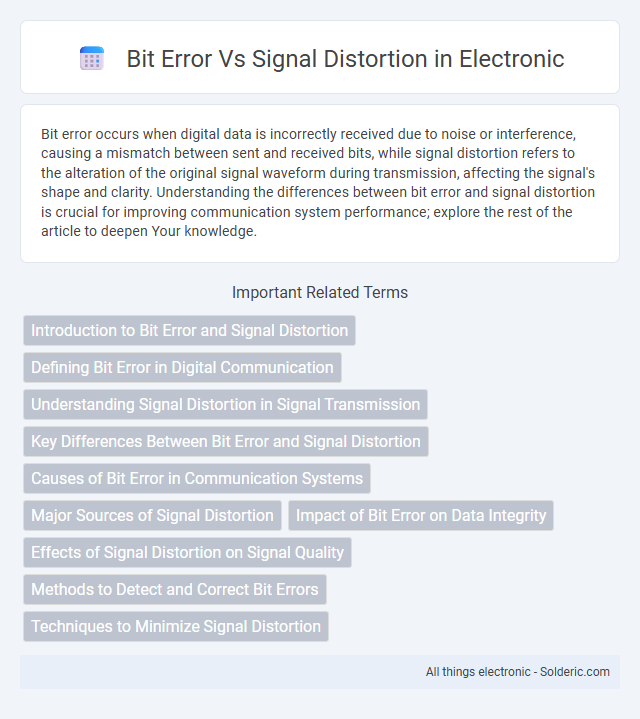Bit error occurs when digital data is incorrectly received due to noise or interference, causing a mismatch between sent and received bits, while signal distortion refers to the alteration of the original signal waveform during transmission, affecting the signal's shape and clarity. Understanding the differences between bit error and signal distortion is crucial for improving communication system performance; explore the rest of the article to deepen Your knowledge.
Comparison Table
| Aspect | Bit Error | Signal Distortion |
|---|---|---|
| Definition | Incorrect bit received due to noise or interference | Alteration of signal waveform during transmission |
| Cause | Noise, interference, fading, synchronization issues | Multipath, bandwidth limitations, non-linearities |
| Effect | Data corruption, increased Bit Error Rate (BER) | Signal attenuation, temporal spreading, inter-symbol interference |
| Detection | Error detection codes, BER measurement | Signal analysis, eye diagram, frequency response |
| Mitigation | Error correction codes, signal retransmission | Equalization, filtering, channel coding |
| Measurement Metric | Bit Error Rate (BER) | Distortion Index, Signal-to-Noise Ratio (SNR) |
Introduction to Bit Error and Signal Distortion
Bit error refers to the incorrect flipping of binary digits during data transmission, often caused by noise, interference, or channel imperfections. Signal distortion entails the alteration of a signal's original shape due to factors such as attenuation, non-linearities, and bandwidth limitations, which can degrade communication quality. Both phenomena significantly impact digital communication systems by increasing error rates and reducing signal integrity, thereby necessitating advanced error correction and distortion mitigation techniques.
Defining Bit Error in Digital Communication
Bit error in digital communication occurs when a transmitted bit is incorrectly received due to noise, interference, or signal distortion affecting signal integrity. Signal distortion alters the shape or timing of the transmitted signal, leading to incorrect interpretation of bits at the receiver end. Understanding the causes of bit errors helps improve error detection and correction techniques, ensuring your communication system maintains reliable data transmission.
Understanding Signal Distortion in Signal Transmission
Signal distortion occurs when the transmitted signal deviates from its original form due to interference, noise, or channel imperfections, leading to altered waveform characteristics. This distortion increases the likelihood of bit errors by causing incorrect interpretation of binary data during the receiver's decoding process. Understanding how signal distortion affects your data transmission helps optimize communication systems to reduce bit error rates and maintain signal integrity.
Key Differences Between Bit Error and Signal Distortion
Bit error refers to the incorrect flipping of a binary digit during data transmission, resulting in a discrepancy between the sent and received bits, while signal distortion involves any alteration in the signal waveform that degrades its quality or alters its intended shape. Bit errors directly impact data integrity and require error detection or correction mechanisms, whereas signal distortion affects the overall signal clarity and may contribute to bit errors indirectly. Understanding the distinction helps you optimize communication systems by targeting bit error reduction through coding and minimizing signal distortion via proper signal conditioning.
Causes of Bit Error in Communication Systems
Bit errors in communication systems primarily result from signal distortion caused by noise, attenuation, and interference during transmission. Factors such as multipath propagation, bandwidth limitations, and nonlinearities in the communication channel degrade the signal integrity, leading to incorrect bit detection. Your system's bit error rate increases when these distortions disrupt the accurate recovery of the transmitted data.
Major Sources of Signal Distortion
Major sources of signal distortion include noise, interference, and bandwidth limitations, which degrade the signal quality and increase bit error rates. Nonlinearities in transmission channels and multipath propagation cause phase shifts and amplitude variations, further distorting the signal. Understanding these factors helps you mitigate errors and maintain data integrity in communication systems.
Impact of Bit Error on Data Integrity
Bit errors directly compromise data integrity by altering the original binary information during transmission, leading to corrupted or lost data packets. Signal distortion increases the likelihood of bit errors by degrading the quality and clarity of the transmitted signal, causing more frequent misinterpretations of bits. Effective error detection and correction mechanisms are essential to mitigate the impact of bit errors and preserve data accuracy in communication systems.
Effects of Signal Distortion on Signal Quality
Signal distortion directly degrades signal quality by altering the original waveform, causing errors in data transmission known as bit errors. Distorted signals increase the bit error rate (BER), reducing communication reliability and clarity. Understanding how distortion affects your system helps optimize error correction and improve overall signal integrity.
Methods to Detect and Correct Bit Errors
Bit errors caused by signal distortion can be detected using error detection codes such as parity checks, cyclic redundancy checks (CRC), and checksums, which identify inconsistencies in transmitted data. Error correction methods like forward error correction (FEC) and automatic repeat request (ARQ) enable your communication system to correct or retransmit erroneous bits, ensuring data integrity despite distortion. Advanced techniques combine these methods to optimize reliability in noisy or distorted transmission environments.
Techniques to Minimize Signal Distortion
Techniques to minimize signal distortion include equalization, which compensates for channel-induced signal alterations by adjusting frequency response, and the implementation of adaptive filters that dynamically correct distortions in real-time. Error correction codes such as Reed-Solomon and convolutional codes help reduce bit errors caused by distorted signals by detecting and correcting errors during data transmission. Employing high-quality components and maintaining proper impedance matching in transmission lines also significantly reduce signal distortion and improve overall communication reliability.
bit error vs signal distortion Infographic

 solderic.com
solderic.com